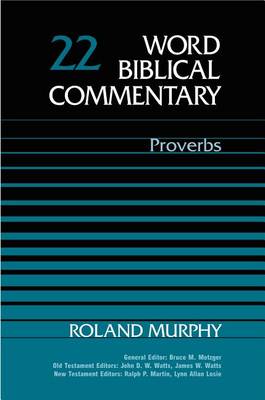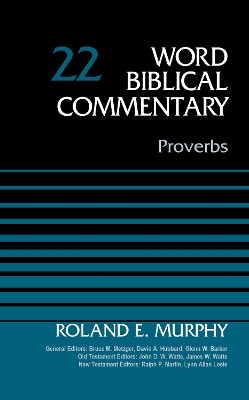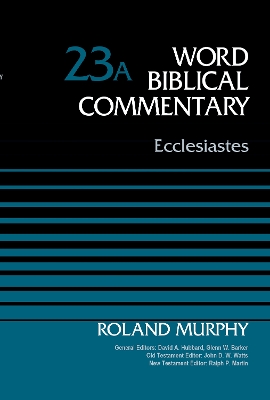Word Biblical Commentary
3 total works
"Proverbs is the fountainhead of the wisdom movement, providing 'old things and new, ' " explains Dr. Roland E. Murphy. Yet in the field of wisdom studies Proverbs has suffered a certain neglect. Even Dr. Murphy admits that during his career as a scholar he did "almost anything else with wisdom literature except write a commentary on this book."
Drawing upon a distinguished academic career, Dr. Murphy now shares his vast insight into Wisdom Literature in this fresh translation and in-depth discussion.
Dr. Murphy approaches Proverbs as "a collection of collections, ... prefaced by an introduction (chaps. 1-9)." The long poems of chapters 1-9 serve to introduce the collections of short sayings in chapters 10-31, which make up most of the book of Proverbs. With this division the writer accepts "the unproven but likely assumption" that during the postexilic period chapters 1-9 "set the tone" for the mostly preexilic collections in chapters I 0-31.
Murphy cautions his readers to consider the limitations of proverbial sayings. The Israelite sages sought in their optimistic teachings to express "the mystery that surrounds all human action: not only self-knowledge, but knowledge of the mysterious role of God." Much of the wisdom of Proverbs points out the ambiguities of life. Yet the proverbs do not provide the final word; "rather they act as a goad, a prod to further thought."
This treatment of Proverbs will be invaluable to clergy and lay readers who desire a penetrating study of the book. The writer leads us through all the types of proverbs: instructions, exhortations of a parent/teacher, speeches of personified Wisdom, and short sayings.
"Israelite wisdom is more practical than theoretical. It attempts to persuade, cajole, threaten, of command a particular attitude or course of action . . . . When the sage says 'listen, ' 'hear, ' the meaning is 'obey.' " Roland Murphy, in this new commentary, helps us uncover this practical message of Proverbs.
The Word Biblical Commentary delivers the best in biblical scholarship, from the leading scholars of our day who share a commitment to Scripture as divine revelation. This series emphasizes a thorough analysis of textual, linguistic, structural, and theological evidence. The result is judicious and balanced insight into the meanings of the text in the framework of biblical theology. These widely acclaimed commentaries serve as exceptional resources for the professional theologian and instructor, the seminary or university student, the working minister, and everyone concerned with building theological understanding from a solid base of biblical scholarship.
Overview of Commentary Organization
- Introduction—covers issues pertaining to the whole book, including context, date, authorship, composition, interpretive issues, purpose, and theology.
- Each section of the commentary includes:
- Pericope Bibliography—a helpful resource containing the most important works that pertain to each particular pericope.
- Translation—the author’s own translation of the biblical text, reflecting the end result of exegesis and attending to Hebrew and Greek idiomatic usage of words, phrases, and tenses, yet in reasonably good English.
- Notes—the author’s notes to the translation that address any textual variants, grammatical forms, syntactical constructions, basic meanings of words, and problems of translation.
- Form/Structure/Setting—a discussion of redaction, genre, sources, and tradition as they concern the origin of the pericope, its canonical form, and its relation to the biblical and extra-biblical contexts in order to illuminate the structure and character of the pericope. Rhetorical or compositional features important to understanding the passage are also introduced here.
- Comment—verse-by-verse interpretation of the text and dialogue with other interpreters, engaging with current opinion and scholarly research.
- Explanation—brings together all the results of the discussion in previous sections to expose the meaning and intention of the text at several levels: (1) within the context of the book itself; (2) its meaning in the OT or NT; (3) its place in the entire canon; (4) theological relevance to broader OT or NT issues.
- General Bibliography—occurring at the end of each volume, this extensive bibliographycontains all sources used anywhere in the commentary.
The Word Biblical Commentary delivers the best in biblical scholarship, from the leading scholars of our day who share a commitment to Scripture as divine revelation. This series emphasizes a thorough analysis of textual, linguistic, structural, and theological evidence. The result is judicious and balanced insight into the meanings of the text in the framework of biblical theology. These widely acclaimed commentaries serve as exceptional resources for the professional theologian and instructor, the seminary or university student, the working minister, and everyone concerned with building theological understanding from a solid base of biblical scholarship.
Overview of Commentary Organization
- Introduction—covers issues pertaining to the whole book, including context, date, authorship, composition, interpretive issues, purpose, and theology.
- Each section of the commentary includes:
- Pericope Bibliography—a helpful resource containing the most important works that pertain to each particular pericope.
- Translation—the author’s own translation of the biblical text, reflecting the end result of exegesis and attending to Hebrew and Greek idiomatic usage of words, phrases, and tenses, yet in reasonably good English.
- Notes—the author’s notes to the translation that address any textual variants, grammatical forms, syntactical constructions, basic meanings of words, and problems of translation.
- Form/Structure/Setting—a discussion of redaction, genre, sources, and tradition as they concern the origin of the pericope, its canonical form, and its relation to the biblical and extra-biblical contexts in order to illuminate the structure and character of the pericope. Rhetorical or compositional features important to understanding the passage are also introduced here.
- Comment—verse-by-verse interpretation of the text and dialogue with other interpreters, engaging with current opinion and scholarly research.
- Explanation—brings together all the results of the discussion in previous sections to expose the meaning and intention of the text at several levels: (1) within the context of the book itself; (2) its meaning in the OT or NT; (3) its place in the entire canon; (4) theological relevance to broader OT or NT issues.
- General Bibliography—occurring at the end of each volume, this extensive bibliographycontains all sources used anywhere in the commentary.


